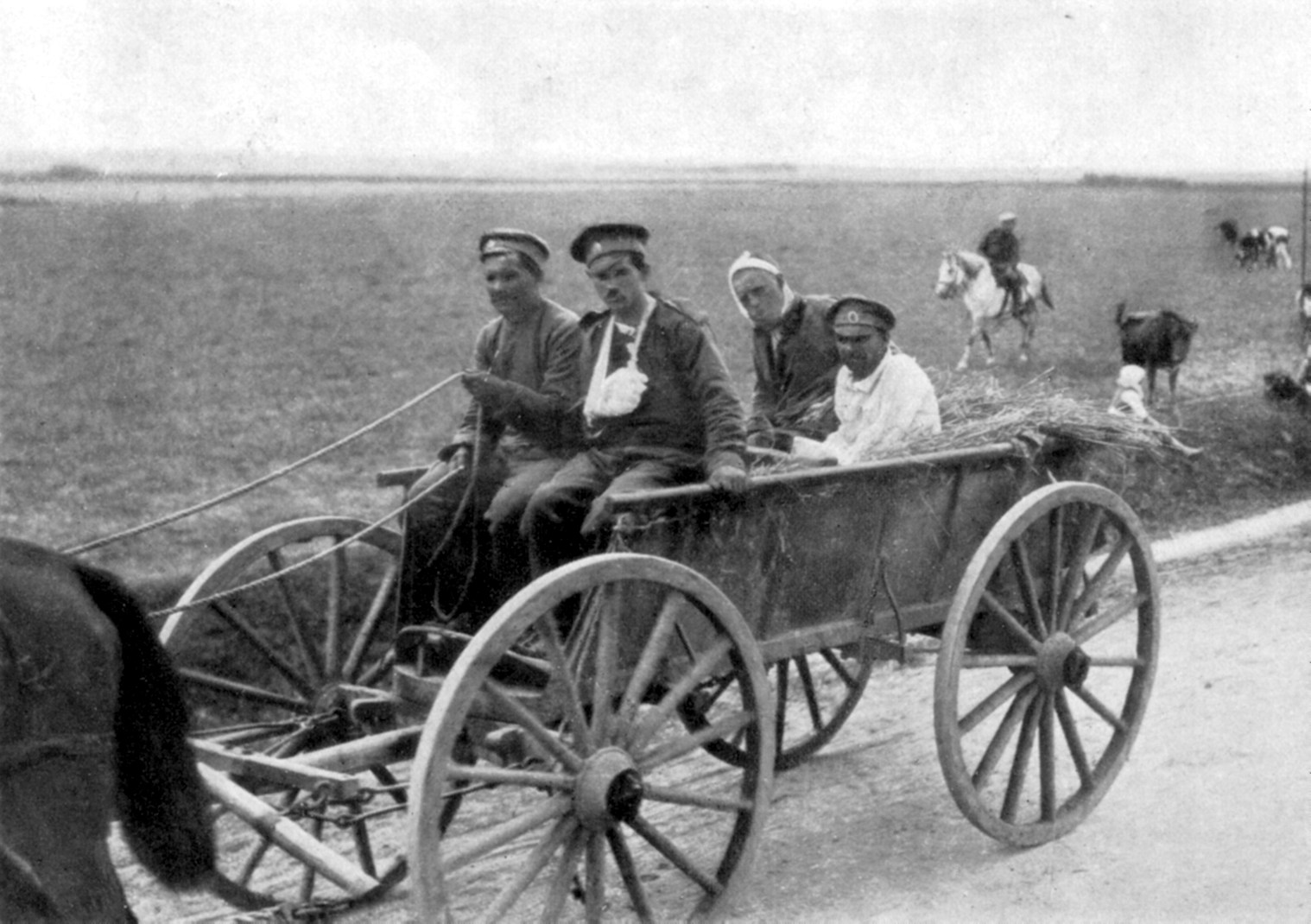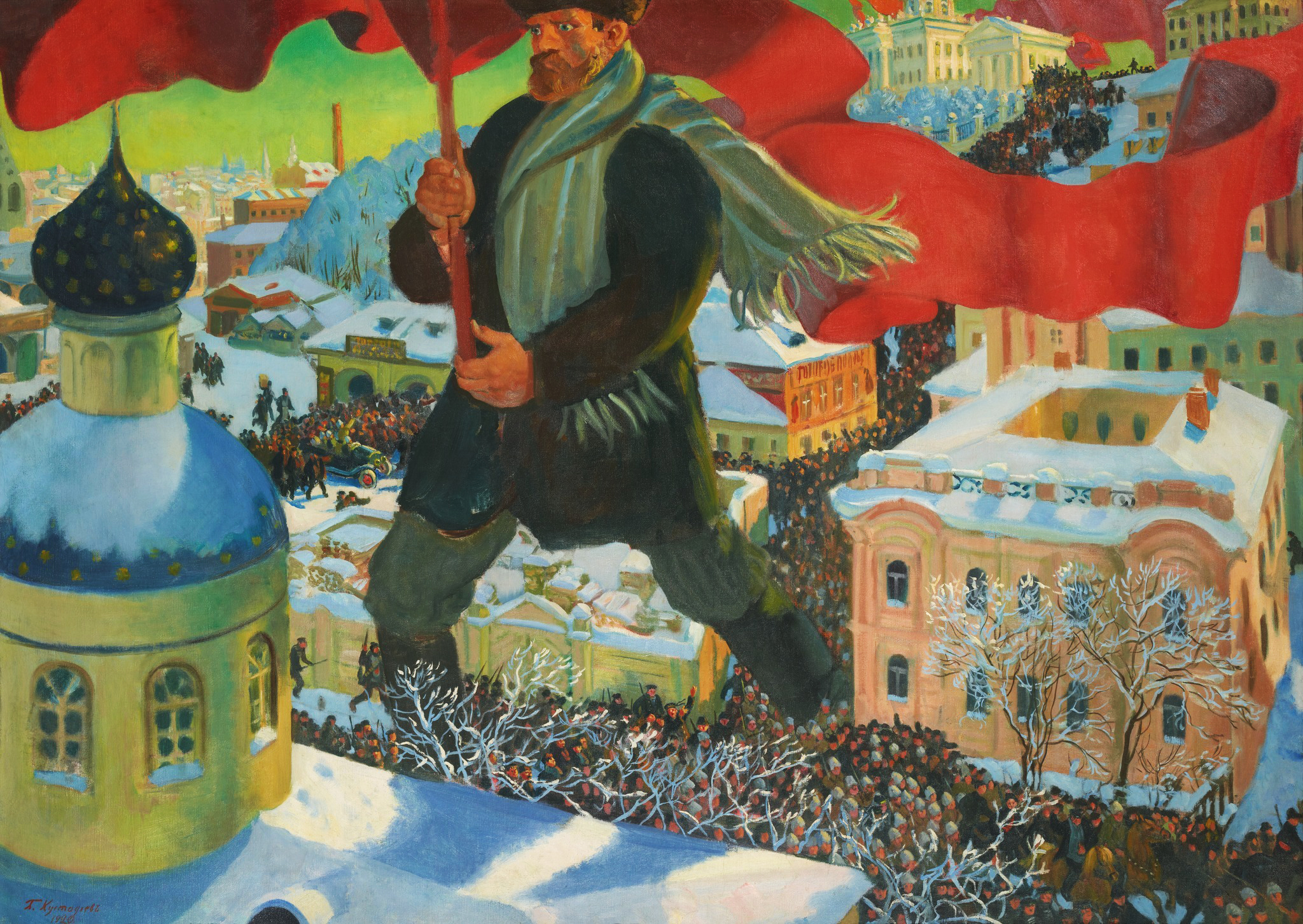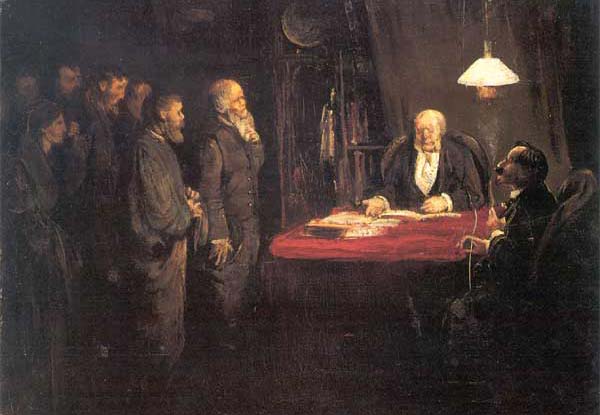|
All-Russian Congress Of Soviets
The All-Russian Congress of Soviets evolved from 1917 to become the supreme governing body of the Russian Soviet Federative Socialist Republic from 1918 until 1936, effectively. The 1918 Constitution of the Russian SFSR mandated that Congress shall convene at least twice a year, with the duties of defining (and amending) the principles of the Soviet Constitution and ratifying peace treaties. The October Revolution ousted the provisional government of 1917, making the Congress of Soviets the sole, and supreme governing body. This Congress was not the same as the Congress of Soviets of the Soviet Union which governed the whole Soviet Union after its creation in 1922. For the earlier portion of its life, the Congress was a democratic body. Over Russia there were hundreds of soviets, democratic local governing bodies in which the surrounding population could participate. The soviets elected the delegates to the Congress, and then in turn the Congress held the national authority, m ... [...More Info...] [...Related Items...] OR: [Wikipedia] [Google] [Baidu] [Amazon] |
Russian Provisional Government
The Russian Provisional Government was a provisional government of the Russian Empire and Russian Republic, announced two days before and established immediately after the abdication of Nicholas II on 2 March, O.S. New_Style.html" ;"title="5 March 1917, New Style">N.S. during the February Revolution. The intention of the provisional government was the organization of elections to the Russian Constituent Assembly and its convention. The provisional government, led first by Prince Georgy Lvov and then by Alexander Kerensky, lasted approximately eight months, and ceased to exist when the Bolsheviks gained power in the October Revolution in October ovember, N.S.1917. According to Harold Whitmore Williams, the history of the eight months during which Russia was ruled by the Provisional Government was the history of the steady and systematic disorganization of the army. The Provisional Government was a caretaker government, with its political system and the status of the monarc ... [...More Info...] [...Related Items...] OR: [Wikipedia] [Google] [Baidu] [Amazon] |
All-Russian Central Executive Committee
The All-Russian Central Executive Committee () was (June – November 1917) a permanent body formed by the First All-Russian Congress of Soviets of Workers' and Soldiers' Deputies (held from June 16 to July 7, 1917 in Petrograd), then became the supreme governing body of the Russian Soviet Federative Socialist Republic in between sessions of the All-Russian Congress of Soviets from 1917 to 1937. In 1937, the All-Russian Central Executive Committee was replaced with the Presidium of the Supreme Soviet of the Russian SFSR. At formation, its full name was the All-Russian Central Executive Committee of the Soviets of Workers' and Soldiers' Deputies. Later it was the All-Russian Central Executive Committee of the Soviets of Workers', Peasants', Red Army, and Cossack Deputies (). Organization The 1918 Russian Constitution required that the All-Russian Central Executive Committee convene the All-Russian Congress of Soviets at least twice a year (Statute 26 of Article III). Additional ... [...More Info...] [...Related Items...] OR: [Wikipedia] [Google] [Baidu] [Amazon] |
Dual Power (Russian Revolution)
Dual power, sometimes referred to as counterpower, refers to a strategy in which alternative institutions coexist with and seek to ultimately replace existing authority. The term was first used by the communist Bolshevik leader Vladimir Lenin (1870–1924) in the 1917 ''Pravda'' article titled "The Dual Power" (''Двоевластие, Dvoyevlastiye''), referring to the coexistence of two Russian governments as a result of the February Revolution: the Soviets (workers' councils), particularly the Petrograd Soviet, and the Russian Provisional Government. Lenin saw this unstable power dynamic as an opportunity for revolutionaries to seize control. This notion has informed the strategies of subsequent communist-led revolutions elsewhere in the world, including the Chinese Communist Revolution led by Mao Zedong (1893–1976) after the Chinese Civil War (1927–1949) and in eastern Europe after World War II (1939–1945). While the term was initially associated with Bolshevik str ... [...More Info...] [...Related Items...] OR: [Wikipedia] [Google] [Baidu] [Amazon] |
February Revolution
The February Revolution (), known in Soviet historiography as the February Bourgeois Democratic Revolution and sometimes as the March Revolution or February Coup was the first of Russian Revolution, two revolutions which took place in Russia in 1917. The main events of the revolution took place in and near Petrograd (now Saint Petersburg), the then-capital of Russia, where long-standing discontent with the monarchy erupted into mass protests against food rationing on 23 February Old Style and New Style dates, Old Style (8 March Old Style and New Style dates, New Style). Revolutionary activity lasted about eight days, involving mass demonstrations and violent armed clashes with police and Special Corps of Gendarmes, gendarmes, the last loyal forces of the Russian monarchy. On 27 February O.S. (12 March N.S.), most of the forces of the capital's garrison sided with the revolutionaries. In the same day, the Russian Provisional Government, made up by left-leaning State Duma (Russ ... [...More Info...] [...Related Items...] OR: [Wikipedia] [Google] [Baidu] [Amazon] |
April Theses
The April Theses (, transliteration: ') were a series of ten directives issued by the Bolshevik leader Vladimir Lenin upon his April 1917 return to Petrograd from his exile in Switzerland via Germany and Finland. The theses were mostly aimed at fellow Bolsheviks in Russia and returning to Russia from exile. He called for soviets (workers' councils) to seize state power (as seen in the slogan "all power to the soviets"), denounced liberals and social revolutionaries in the Provisional Government, called for Bolsheviks not to cooperate with the government, and called for new communist policies. The April Theses influenced the July Days and October Revolution in the next months and are identified with Leninism. Background The February Revolution had resulted in the abdication of Tsar Nicholas II, the collapse of Imperial Russia, and the establishment of the liberal Provisional Government under Georgy Lvov and later Alexander Kerensky. The Provisional Government was dominat ... [...More Info...] [...Related Items...] OR: [Wikipedia] [Google] [Baidu] [Amazon] |
Vladimir Lenin
Vladimir Ilyich Ulyanov ( 187021 January 1924), better known as Vladimir Lenin, was a Russian revolutionary, politician and political theorist. He was the first head of government of Soviet Russia from 1917 until Death and state funeral of Vladimir Lenin, his death in 1924, and of the Soviet Union from 1922 until his death. As the founder and leader of the Bolsheviks, Lenin led the October Revolution which established the world's first socialist state. His government won the Russian Civil War and created a one-party state under the Communist Party of the Soviet Union, Communist Party. Ideologically a Marxist, his developments to the ideology are called Leninism. Born into a middle-class family in Simbirsk in the Russian Empire, Lenin embraced revolutionary socialist politics after Aleksandr Ulyanov, his brother was executed in 1887 for plotting to assassinate Alexander III of Russia, the tsar. He was expelled from Kazan Imperial University for participating in student prote ... [...More Info...] [...Related Items...] OR: [Wikipedia] [Google] [Baidu] [Amazon] |
Bolsheviks
The Bolsheviks, led by Vladimir Lenin, were a radical Faction (political), faction of the Marxist Russian Social Democratic Labour Party (RSDLP) which split with the Mensheviks at the 2nd Congress of the Russian Social Democratic Labour Party, Second Party Congress in 1903. The Bolshevik party, formally established in 1912, seized power in Russia in the October Revolution of 1917, and was later renamed the Russian Communist Party, All-Union Communist Party, and ultimately the Communist Party of the Soviet Union. Its ideology, based on Leninism, Leninist and later Marxism–Leninism, Marxist–Leninist principles, became known as Bolshevism. The origin of the RSDLP split was Lenin's support for a smaller party of professional revolutionaries, as opposed to the Menshevik desire for a broad party membership. The influence of the factions fluctuated in the years up to 1912, when the RSDLP formally split in two. The political philosophy of the Bolsheviks was based on the Leninist pr ... [...More Info...] [...Related Items...] OR: [Wikipedia] [Google] [Baidu] [Amazon] |
Socialist-Revolutionaries
The Socialist Revolutionary Party (SR; ,, ) was a major socialist political party in the late Russian Empire, during both phases of the Russian Revolution, and in early Soviet Russia. The party members were known as Esers (). The SRs were agrarian socialists and supporters of a democratic socialist Russian republic. The ideological heirs of the Narodniks, the SRs won a mass following among the Russian peasantry by endorsing the overthrow of the Tsar and the redistribution of land to the peasants. The SRs boycotted the elections to the First Duma following the Revolution of 1905 alongside the Russian Social Democratic Labour Party, but chose to run in the elections to the Second Duma and received the majority of the few seats allotted to the peasantry. Following the 1907 coup, the SRs boycotted all subsequent Dumas until the fall of the Tsar in the February Revolution of March 1917. Controversially, the party leadership endorsed the Russian Provisional Government and participa ... [...More Info...] [...Related Items...] OR: [Wikipedia] [Google] [Baidu] [Amazon] |
Mensheviks
The Mensheviks ('the Minority') were a faction of the Marxist Russian Social Democratic Labour Party (RSDLP) which split with Vladimir Lenin's Bolshevik faction at the Second Party Congress in 1903. Mensheviks held more moderate and reformist views as compared to the Bolsheviks, and were led by figures including Julius Martov and Pavel Axelrod. The initial point of disagreement was the Mensheviks' support for a broad party membership, as opposed to Lenin's support for a smaller party of professional revolutionaries. The Bolsheviks gained a majority on the Central Committee in 1903, although the power of the two factions fluctuated in the following years. Mensheviks were associated with Georgi Plekhanov's position that a bourgeois-democratic revolution and period of capitalism would need to occur before the conditions for a socialist revolution emerged. Some Mensheviks, notably Alexander Potresov, called for the party to suspend illegal revolutionary work to focus more on ... [...More Info...] [...Related Items...] OR: [Wikipedia] [Google] [Baidu] [Amazon] |
Strike Action
Strike action, also called labor strike, labour strike in British English, or simply strike, is a work stoppage caused by the mass refusal of employees to Working class, work. A strike usually takes place in response to employee grievances. Strikes became common during the Industrial Revolution, when Labour economics, mass labor became important in factories and mines. As striking became a more common practice, governments were often pushed to act (either by private business or by union workers). When government intervention occurred, it was rarely neutral or amicable. Early strikes were often deemed unlawful conspiracies or anti-competitive cartel action and many were subject to massive legal repression by state police, federal military power, and federal courts. Many Western nations legalized striking under certain conditions in the late 19th and early 20th centuries. Strikes are sometimes used to pressure governments to change policies. Occasionally, strikes destabilize the r ... [...More Info...] [...Related Items...] OR: [Wikipedia] [Google] [Baidu] [Amazon] |
1905 Russian Revolution
The Russian Revolution of 1905, also known as the First Russian Revolution, was a revolution in the Russian Empire which began on 22 January 1905 and led to the establishment of a constitutional monarchy under the Russian Constitution of 1906, the country's first. The revolution was characterized by mass political and social unrest including worker strike action, strikes, peasant revolts, and military mutiny, mutinies directed against Tsar Nicholas II and the Tsarist autocracy, autocracy, who were forced to establish the State Duma (Russian Empire), State Duma legislative assembly and grant certain rights, though both were later undermined. In the years leading up to the revolution, impoverished peasants had become increasingly angered by repression from their Landlord, landlords and the continuation of semi-feudal relations. Further discontent grew due to mounting Russian losses in the Russo-Japanese War, poor conditions for workers, and urban unemployment. On , known as "Bloody ... [...More Info...] [...Related Items...] OR: [Wikipedia] [Google] [Baidu] [Amazon] |
Supreme Soviet
The Supreme Soviet () was the common name for the legislative bodies (parliaments) of the Soviet socialist republics (SSR) in the Union of Soviet Socialist Republics (USSR). These soviets were modeled after the Supreme Soviet of the USSR, established in 1938, and were nearly identical. Party-approved delegates to the Supreme Soviets were periodically elected unopposed in show elections. The Demokratizatsiya (Soviet Union), first free or semi-free elections took place during ''perestroika'' in late 1980s, in which Supreme Soviets themselves were no longer directly elected. Instead, Supreme Soviets were appointed by directly elected Congress of People's Deputies of the Soviet Union, Congresses of People's Deputies based somewhat on the Congress of Soviets, Congresses of Soviets that preceded the Supreme Soviets. The soviets until then were largely Rubber stamp (politics), rubber-stamp institutions, approving decisions handed to them by the Communist Party of the USSR or of each SSR ... [...More Info...] [...Related Items...] OR: [Wikipedia] [Google] [Baidu] [Amazon] |







